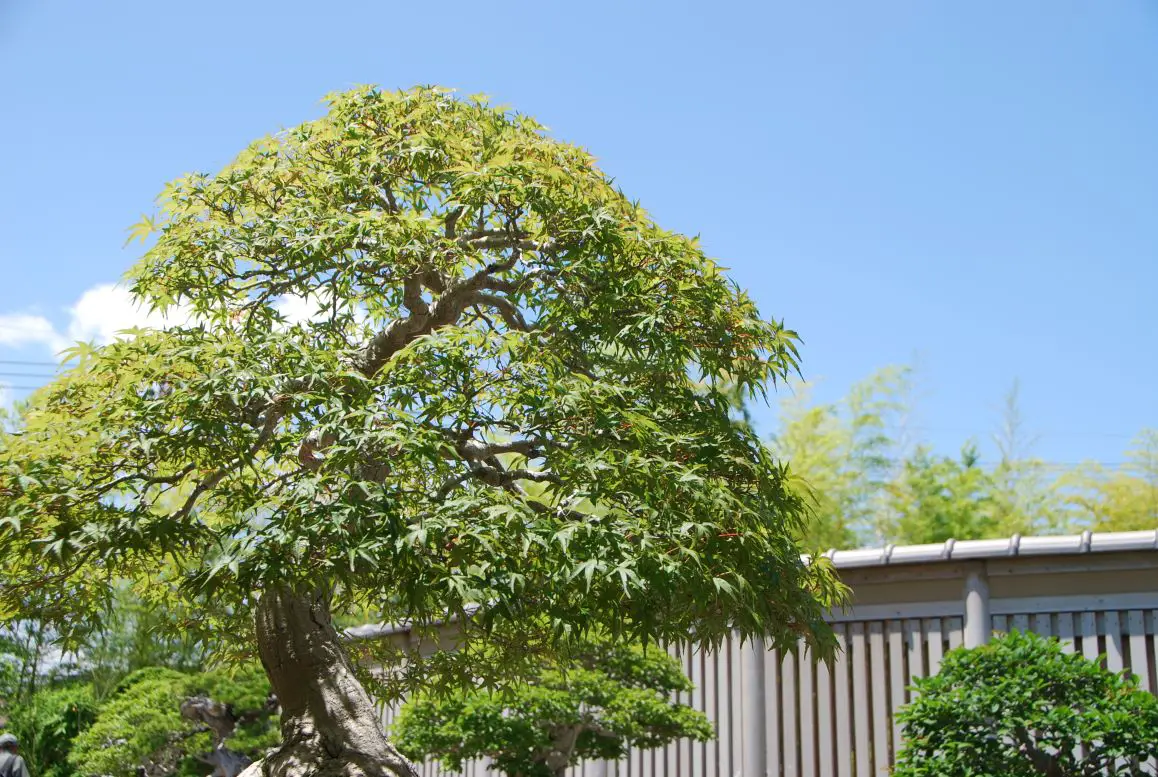The thermal death limit for bonsai trees is about 115°F (46°C), while they thrive within a temperature range of 60 to 85°F (16 to 29°C) where they enjoy optimal growing conditions.
Bonsai heat-stress threshold
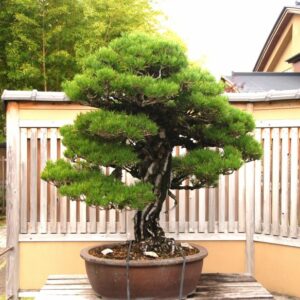
Plants, including bonsai trees, have a limit to how much heat they can tolerate. The gravity of heat stress increases rapidly as the air temperature rises above 85°F (29°C) and the thermal death limit is around 115°F (46°C) for temperate zone trees like most bonsai species.
Once temperatures reach that limit, trees’ protein that makes up their cells starts to break down and they will eventually die.
That said, this hot temperature limit is not an absolute number as it is influenced by several factors that can either enhance or hinder trees’ ability to withstand high temperatures.
Factors affecting bonsai heat tolerance
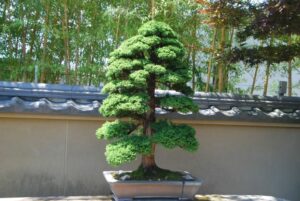
There are several factors that play a key role in bonsai heat tolerance, which can be categorized into 3 groups:
- Physiological factors
- External influences
- Tree characteristics
Physiological factors
Physiological factors refer to the internal processes and responses within a bonsai tree that affects its heat tolerance. Here are the key physiological factors that influence heat tolerance.
Water content

The water content within the tree’s body plays a vital role in heat tolerance. To cool themselves, bonsai trees evaporate water through their leaves just as we humans sweat to cool ourselves down. This process is called transpiration.
By transpiration, the heat in the leaves is transferred to the vapor to the air which enables the plant to cool down, followed by water pulling from the stem and roots into the leaves.
About 90% of the water that enters a tree’s roots is used for cooling on a hot, dry day. Without water, the wind is the only means of keeping tree temperatures down, which could well be very hot (and very bad for trees).
So, sufficient water available in the tree’s body is crucial to regulate its internal temperature and prevent dehydration during hot conditions.
Ability to adjust to temperature changes
Plants, including bonsai trees, have mechanisms inside their body that enable them to adjust and adapt to temperature fluctuations. These mechanisms involve various physiological processes including changes in transpiration rates, stomatal conductance (the pores on leaves), and photosynthesis.
Bonsai trees use these mechanisms to adjust to temperature changes to maintain optimal physiological functions and minimize heat-induced stress. This ability to adjust to temperature changes depends on genetic traits, acclimation and adaptation, and their natural habitat.
Different plant species have genetic variations that determine their temperature tolerance. Trees that have the ability to acclimate to hot weather may not be able to do so if the change is very sudden or extreme. Trees from hot regions have mechanisms to thrive in hot conditions.
External influences
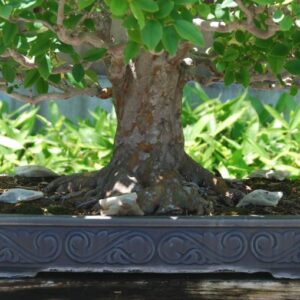
External factors such as the duration of hot temperatures, the absolute highest temperature reached, nighttime temperature, air movement and humidity also affect bonsai trees’ heat tolerance.
Duration and absolute high temperature
When the duration of high temperatures exceeded a tree’s ability to adapt, avoid, or repair any problems that arise, even shorter periods of extreme high temperatures can cause damage to trees. As the duration of such extreme temperatures lengthens, trees become more susceptible to damage.
Nighttime temperature
Nighttime temperature is also an important factor for determining their heat tolerance. It controls the respiration rates of the entire tree and the soil. When temperatures are warmer at night, respiration happens more quickly, leading to increased water loss and need.
Container plant
Another thing that is unique to bonsai trees is that they are plated in a tiny pot.
Trees that are grown in containers above the ground which are exposed to direct sunlight experience much higher levels of heat than those grown in the ground. This is simply because they do not have enough insulation: the soil around them.
So, the tinier and shallower the posts are, the less insulation there is. The soil itself absorbs heat but the pots exposed to sunlight can quickly absorb heat as well. For example, black plastic containers can absorb energy and become as hot as 125°F (52°C) or more.
This intense heat can cause damage to the roots and shoots of the trees. It starts with inhibiting root growth, followed by a decline in water uptake, wilting of leaves, damage to the roots, and eventually, the death of leaves and shoots.
This is why it is not recommended to use black plastic containers, especially in hot areas in summer.
Tree characteristics

Tree species
Different bonsai species exhibit varying degrees of heat tolerance. Some species like pines are known for their resilience in hot climates, while others like Japanese maples may be more sensitive to heat stress.
Also, the origin of your bonsai tree can provide insights into its heat tolerance. Bonsai trees native to regions with hot climates, such as olive or citrus trees, have likely developed adaptations to withstand and thrive in high temperatures.
Age and size
Younger and smaller trees may be more susceptible to heat stress because their leaves are fragile and the bark is still thin.
Optimal temperature range for bonsai trees
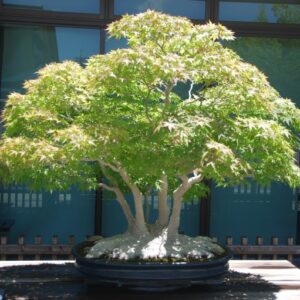
Bonsai trees enjoy optimum growing conditions when the temperature ranges between 60 to 85°F (16 to 29°C). Most bonsai trees thrive within this moderate temperature range, though, of course, the specific temperature requirements may vary depending on the species.
The gravity of heat stress increases rapidly as the air temperature rises above this range. So, maintaining an optimal temperature range is crucial for the health and longevity of your bonsai trees. This range provides a balance between promoting growth and photosynthesis while minimizing the risk of heat stress.
Also, nighttime temperatures should be slightly cooler to allow your trees to recover and rest just like humans.
It’s important to note that individual bonsai trees may have their own temperature preferences and tolerances. Your bonsai trees are unique and you should look for the best conditions for your trees accordingly.
Factors mitigating bonsai heat stress
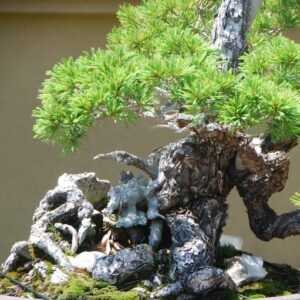
Heat stress can pose significant challenges to bonsai trees, but there are several things that you can do to mitigate its effects and protect the trees from excessive heat.
-
- Provide shade
- Position strategically
- Avoid hot surfaces
- Monitor soil moisture
Above all, soil moisture is the most important factor in mitigating heat stress.
Water should be added to thoroughly moisten the root zone. If the air is humid, the soil surface might look somewhat wet but it can be dry inside the pot. So, you should carefully probe the soil to help determine the moisture content before watering.
It depends on where you live but you might need to water your trees at least twice a day in summer and more during heat waves.
For more in detail, the following post will guide you on how to protect your trees in summer.
—–
References
Coder, Kim D. 2012. Drought, Heat & Trees. University of Georgia.
Suat Irmak. Impacts of Extreme Heat Stress and Increased Soil Temperature on Plant Growth and Development. University of Nebraska, Institute of Agriculture and Natural Resources.

